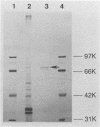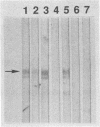Abstract
The herpes simplex virus type 2 (HSV-2) genome codes for an envelope protein, glycoprotein G (gG), which contains predominantly type 2-specific epitopes. A portion of this gG gene has been expressed as a fusion protein in Escherichia coli. Expression was regulated by a lambda phage pL promoter. The 60,000-molecular-weight recombinant protein was purified by ion-exchange chromatography. Amino acid sequence analysis confirmed the N terminus of the purified protein. Mice immunized with recombinant gG developed antibodies reactive with native HSV-2 protein, but not with HSV-1 protein, in an indirect immunofluorescence assay. The serological activity of this purified recombinant gG protein was evaluated by immunoblot assay. This protein was reactive with an HSV-2 gG monoclonal antibody. It was also reactive with HSV-2 rabbit antiserum but not with HSV-1 rabbit antiserum. Of 15 patient serum samples known to have antibody to HSV-2, 14 were reactive with this recombinant type 2-specific gG protein, and none of 15 HSV antibody-negative patient serum samples showed reactivity. In agreement with the expected prevalence of HSV-2 infection, 27.6% of 134 serum samples from random normal individuals had antibodies reactive with recombinant gG. This recombinant gG protein may be of value in detecting HSV-2-specific antibody responses in patients infected with HSV-2.
Full text
PDF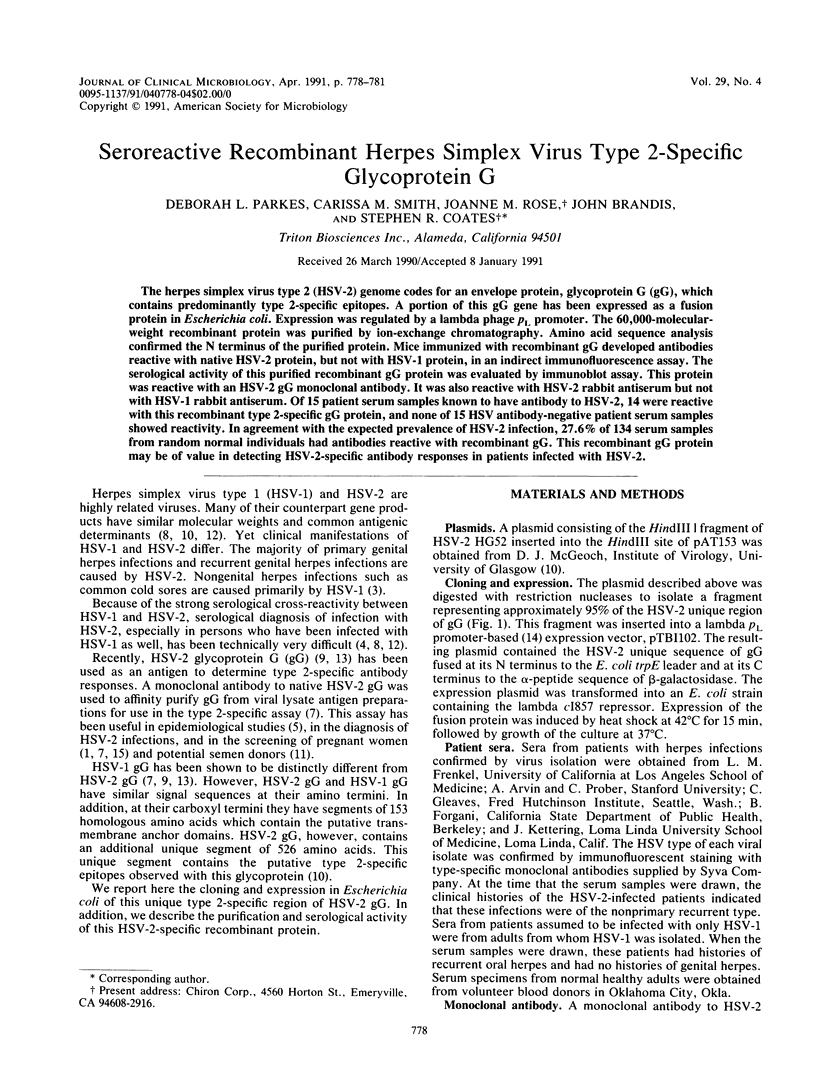
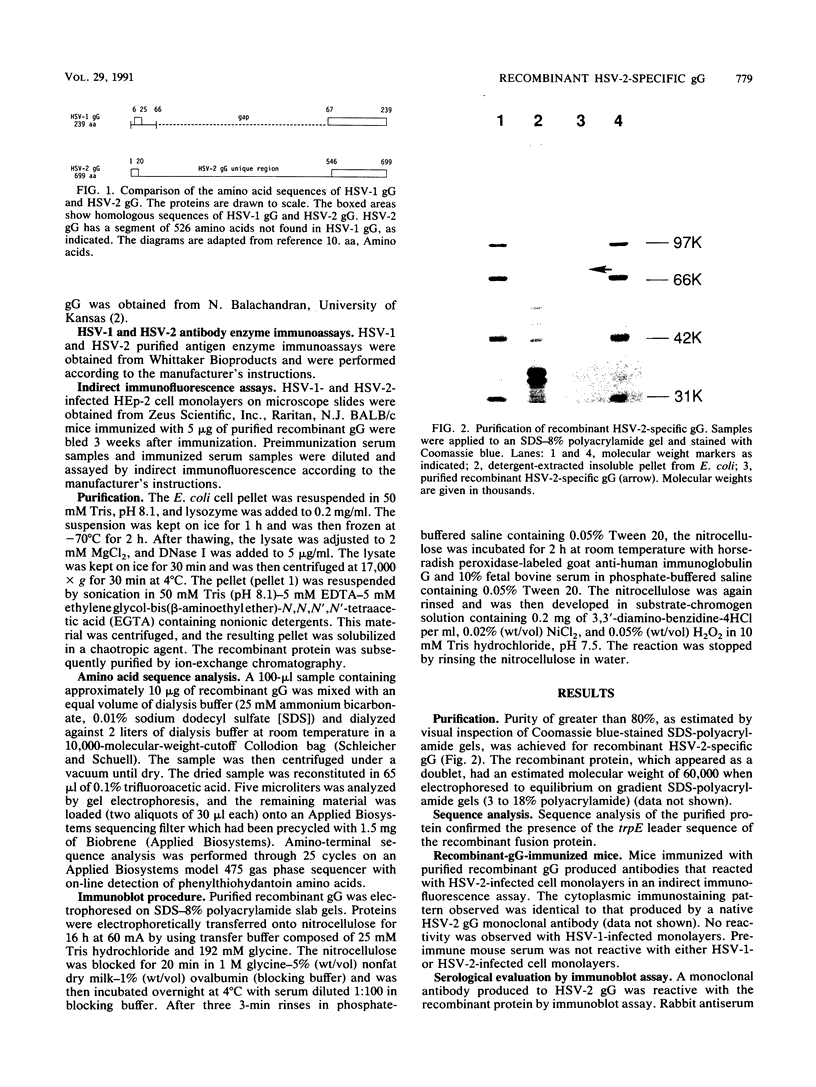
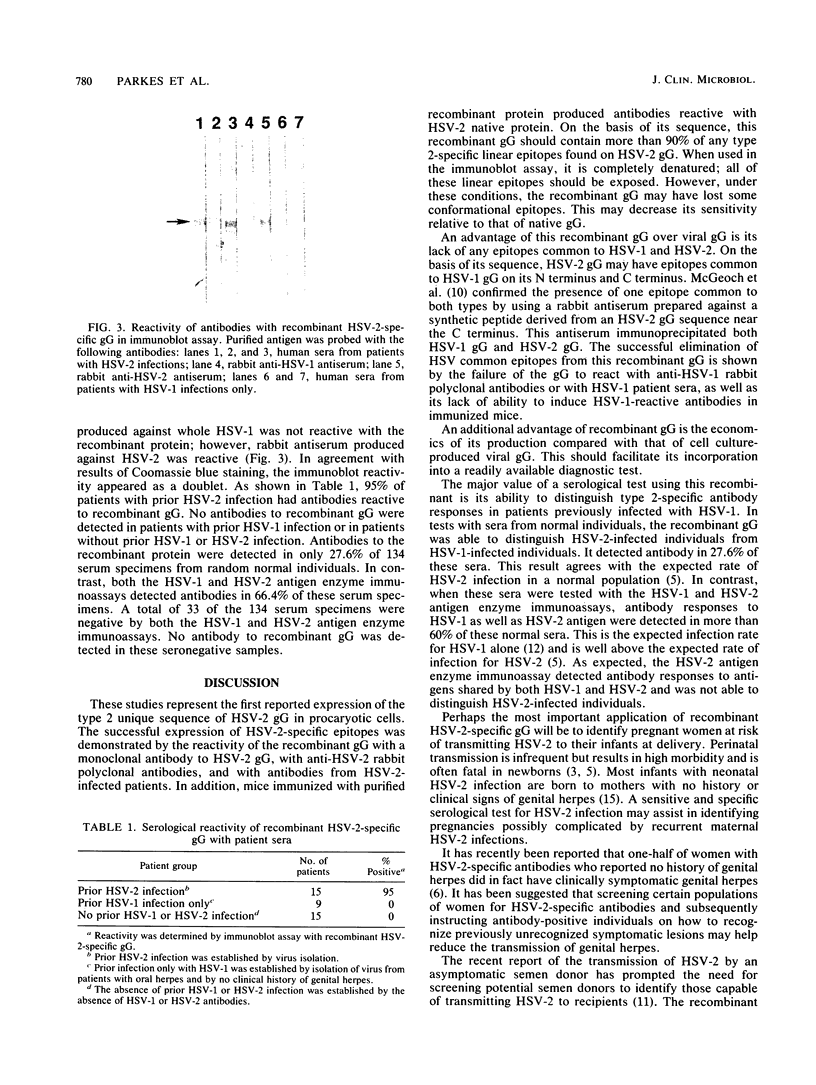
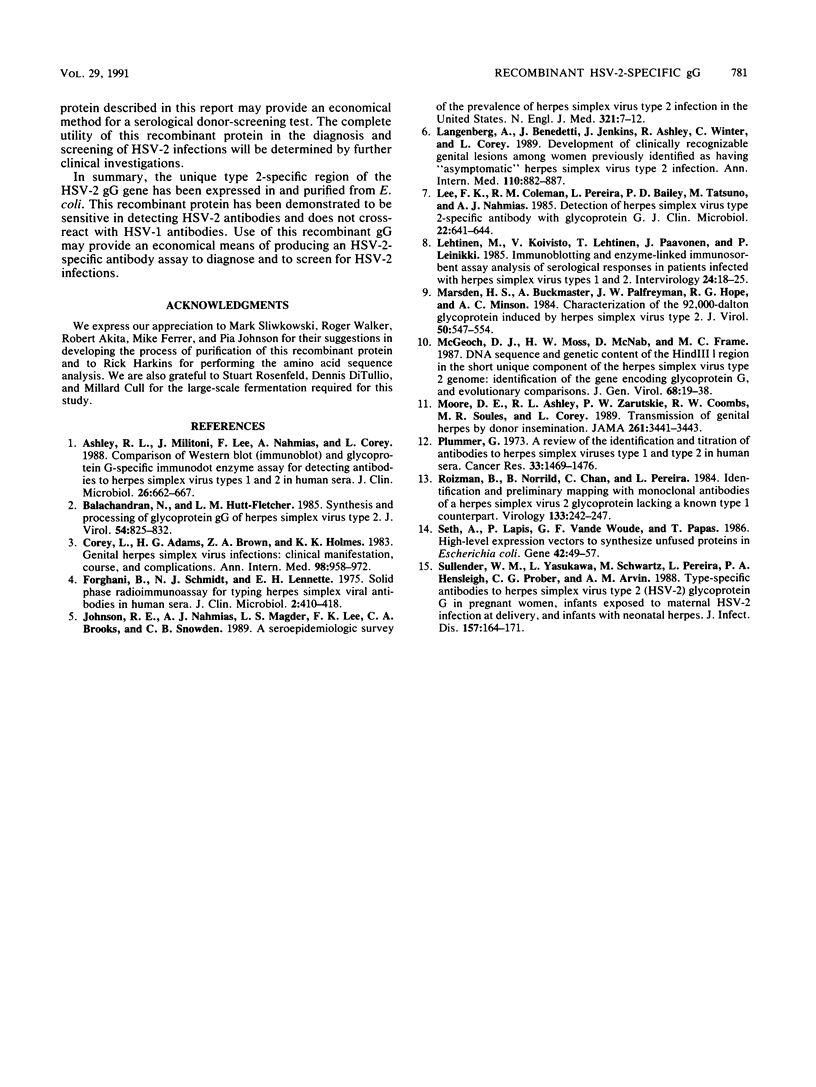
Images in this article
Selected References
These references are in PubMed. This may not be the complete list of references from this article.
- Ashley R. L., Militoni J., Lee F., Nahmias A., Corey L. Comparison of Western blot (immunoblot) and glycoprotein G-specific immunodot enzyme assay for detecting antibodies to herpes simplex virus types 1 and 2 in human sera. J Clin Microbiol. 1988 Apr;26(4):662–667. doi: 10.1128/jcm.26.4.662-667.1988. [DOI] [PMC free article] [PubMed] [Google Scholar]
- Balachandran N., Hutt-Fletcher L. M. Synthesis and processing of glycoprotein gG of herpes simplex virus type 2. J Virol. 1985 Jun;54(3):825–832. doi: 10.1128/jvi.54.3.825-832.1985. [DOI] [PMC free article] [PubMed] [Google Scholar]
- Corey L., Adams H. G., Brown Z. A., Holmes K. K. Genital herpes simplex virus infections: clinical manifestations, course, and complications. Ann Intern Med. 1983 Jun;98(6):958–972. doi: 10.7326/0003-4819-98-6-958. [DOI] [PubMed] [Google Scholar]
- Forghani B., Schmidt N. J., Lennette E. H. Solid phase radioimmunoassay for typing herpes simplex viral antibodies in human sera. J Clin Microbiol. 1975 Nov;2(5):410–418. doi: 10.1128/jcm.2.5.410-418.1975. [DOI] [PMC free article] [PubMed] [Google Scholar]
- Johnson R. E., Nahmias A. J., Magder L. S., Lee F. K., Brooks C. A., Snowden C. B. A seroepidemiologic survey of the prevalence of herpes simplex virus type 2 infection in the United States. N Engl J Med. 1989 Jul 6;321(1):7–12. doi: 10.1056/NEJM198907063210102. [DOI] [PubMed] [Google Scholar]
- Langenberg A., Benedetti J., Jenkins J., Ashley R., Winter C., Corey L. Development of clinically recognizable genital lesions among women previously identified as having "asymptomatic" herpes simplex virus type 2 infection. Ann Intern Med. 1989 Jun 1;110(11):882–887. doi: 10.7326/0003-4819-110-11-882. [DOI] [PubMed] [Google Scholar]
- Lee F. K., Coleman R. M., Pereira L., Bailey P. D., Tatsuno M., Nahmias A. J. Detection of herpes simplex virus type 2-specific antibody with glycoprotein G. J Clin Microbiol. 1985 Oct;22(4):641–644. doi: 10.1128/jcm.22.4.641-644.1985. [DOI] [PMC free article] [PubMed] [Google Scholar]
- Lehtinen M., Koivisto V., Lehtinen T., Paavonen J., Leinikki P. Immunoblotting and enzyme-linked immunosorbent assay analysis of serological responses in patients infected with herpes simplex virus types 1 and 2. Intervirology. 1985;24(1):18–25. doi: 10.1159/000149614. [DOI] [PubMed] [Google Scholar]
- Marsden H. S., Buckmaster A., Palfreyman J. W., Hope R. G., Minson A. C. Characterization of the 92,000-dalton glycoprotein induced by herpes simplex virus type 2. J Virol. 1984 May;50(2):547–554. doi: 10.1128/jvi.50.2.547-554.1984. [DOI] [PMC free article] [PubMed] [Google Scholar]
- McGeoch D. J., Moss H. W., McNab D., Frame M. C. DNA sequence and genetic content of the HindIII l region in the short unique component of the herpes simplex virus type 2 genome: identification of the gene encoding glycoprotein G, and evolutionary comparisons. J Gen Virol. 1987 Jan;68(Pt 1):19–38. doi: 10.1099/0022-1317-68-1-19. [DOI] [PubMed] [Google Scholar]
- Moore D. E., Ashley R. L., Zarutskie P. W., Coombs R. W., Soules M. R., Corey L. Transmission of genital herpes by donor insemination. JAMA. 1989 Jun 16;261(23):3441–3443. [PubMed] [Google Scholar]
- Plummer G. A review of the identification and titration of antibodies to herpes simplex viruses type 1 and type 2 in human sera. Cancer Res. 1973 Jun;33(6):1469–1476. [PubMed] [Google Scholar]
- Roizman B., Norrild B., Chan C., Pereira L. Identification and preliminary mapping with monoclonal antibodies of a herpes simplex virus 2 glycoprotein lacking a known type 1 counterpart. Virology. 1984 Feb;133(1):242–247. doi: 10.1016/0042-6822(84)90447-1. [DOI] [PubMed] [Google Scholar]
- Seth A., Lapis P., Vande Woude G. F., Papas T. High-level expression vectors to synthesize unfused proteins in Escherichia coli. Gene. 1986;42(1):49–57. doi: 10.1016/0378-1119(86)90149-6. [DOI] [PubMed] [Google Scholar]
- Sullender W. M., Yasukawa L. L., Schwartz M., Pereira L., Hensleigh P. A., Prober C. G., Arvin A. M. Type-specific antibodies to herpes simplex virus type 2 (HSV-2) glycoprotein G in pregnant women, infants exposed to maternal HSV-2 infection at delivery, and infants with neonatal herpes. J Infect Dis. 1988 Jan;157(1):164–171. doi: 10.1093/infdis/157.1.164. [DOI] [PubMed] [Google Scholar]



